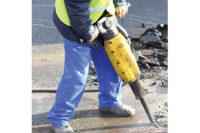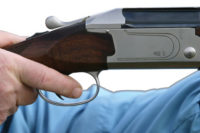High and changing noise levels require hearing protection, but equally important is the need to preserve clear two-way communications, and the ability to hear sounds to assist in situational awareness. These factors are essential safety drivers for many workers across a range of industries — not just the military.
Intelligent hearing systems, which were originally developed for infantry soldiers, are now becoming available for industrial workers. These technically advanced products can enhance wearers’ hearing when needed, and protect them against temporary or permanent damage.
Exposure to high noise levels has long been recognized as an issue by infantry forces which face two types of noise: high, continuous noise generated by vehicles or aircraft; and high impulse noise generated by weapons or explosions. These noise types are equally damaging at work sites. High noise levels include continuous noise from plant machinery, generators and drilling equipment as well as high impact noise from hammering, percussive pressing operations and other harmful noise sources.
High noise levels present during operations
Operational problems associated with exposure from moderate to high noise in military environments include increased levels of fatigue, lack of situational awareness, and a breakdown in ‘command and control’ due to the inability to send and receive intelligible radio communications.
In a military deployment, communications clarity is vital. Intelligible communications at every level, up and down the command chain, is mission critical to ensure messages and commands are received without error, misunderstanding or delay.
These challenges are the same for many industrial workers: increased levels of fatigue affect productivity; lack of situational awareness or isolation from co-workers and the work environment can have a negative impact on worker safety; and unclear communications in some safety-critical scenarios can have catastrophic outcomes.
Reducing the level of exposure to constantly changing noise environments is the key challenge to provide protection and improve communications intelligibility.
Digital active noise reduction
New tactical hearing protection and communications systems, now being deployed, provide automatic hearing protection designed to address the full spectrum of military operations.
Some of these systems use digital Active Noise Reduction (ANR) technology that is effective at combating continuous steady-state noise. The benefit of this can be appreciated when considering the maximum permissible exposure time for a soldier operating within a high-noise environment such as an armored personnel carrier (APC). According to noise exposure regulations, using a standard headset providing minimal passive protection may enable the soldier to remain safely in the vehicle for perhaps three hours. The typical performance of the digital ANR system alone provides an additional 6 dB of attenuation, which means that the soldier within the APC using the digital ANR-equipped solution would be able to remain in the vehicle for 12 hours.
Hearing external sounds
High-level noises are isolated from the user through the use of foam or silicone ear tips. When fitted correctly, these seal the ear canal to provide attenuation from the unwanted external noise.
One intelligent hearing system is designed to test the integrity of the ear tip seal and to perform a ‘fit test’. If it is determined that the fit of either ear tip is insufficient, the user is alerted by the device.
An important safety aspect of innovative hearing protection solutions is this: the user can hear external sounds while the headset is fitted. Some products require the user to control the electronic function manually, while others are always activated and automatically adapt to the external sound level. This function allows external ‘safe level’ sounds to pass through the ear tip.
While external sounds are being heard by the user, when a high-level impulsive sound occurs, the electronics in the device manage the transmission of sounds through the ear tip. The actual level of unwanted impulse sound received by the ear is determined by the NRR rating of the ear tip, the effectiveness of its fit, and the speed and performance of the acoustic processing of the intelligent systems.
Some basic systems ‘clamp’ or ‘compress’ the external sound and limit all sound passed through the tip. An important safety aspect of innovative hearing protection solutions such as these is for the user to hear external sounds while the headset is fitted. The different approaches affect the quality of the wanted external sound heard by the user, the speed of the system to react to an impulse event, and the time to recover to full natural hearing.
Advanced “In-the-Ear” technology
In-the-Ear headset technology solutions feature lightweight ear pieces that fit within the concha (bowl) of the ear and do not obstruct the pinna (outer part). The pinna plays an important role in helping determine direction (localization) of sounds in the user’s immediate surroundings.
A recent advancement in this technology enables workers to determine his or her level of personal sound exposure experienced during each working shift. By monitoring all sound that enters the ear canal (unwanted noise, external sounds and communication from the radio systems), the intelligent hearing system can calculate noise exposure. The worker is alerted when he or she has reached the maximum permissible noise exposure for that work shift.
This alert provides users with a real-time indication of their sound exposure and validation of the effectiveness of the hearing protection achieved. Users no longer have to guess whether they are being protected, nor wait until their next audiogram to determine whether they have suffered any hearing loss.
From the front
The advances offered by these intelligent hearing systems are by no means simply incremental improvements “from the front.” For civilian industrial workers in high-noise environments, clear real-time communications, situational awareness and hearing safety are often as critical as for them as for members of the armed forces engaged in the literally life-threatening environments of military combat and training.
Safety managers must protect workers from noise-induced hearing loss (NIHL), but they must also ensure that workers can communicate with each other, remain aware of the dangers of their work environment and effectively and productively carry out their jobs and tasks. Just as examples, think oil platforms, helicopter pads and steel forges. Any compromise of safety is not an option.
The transfer of state-of-the-art intelligent communications and hearing protection from battlefield technology to industrial use provides a game-changing advantage for safety managers in their mission to create cultures of safety. Intelligent hearing solutions transform vulnerabilities in daily work environments into a productivity advantage. For workers, the technology also offers a dramatic upgrade to enhance their own personal safety and quality of life, while freeing them to focus on achieving their mission-critical goals.



